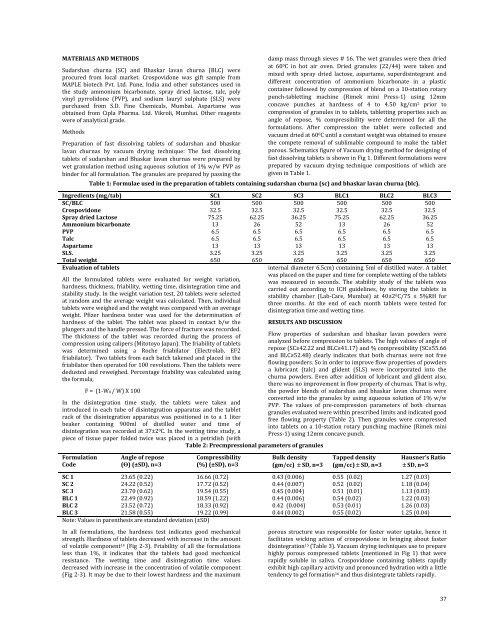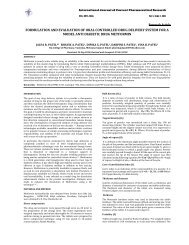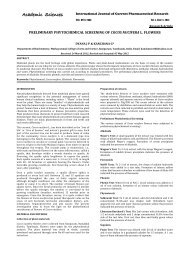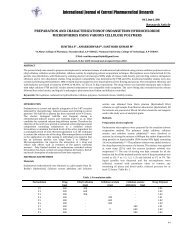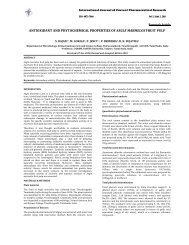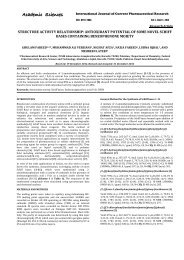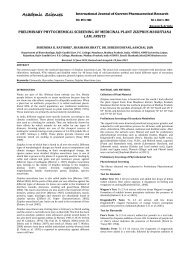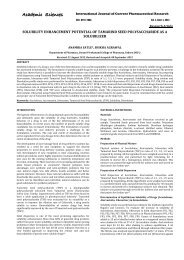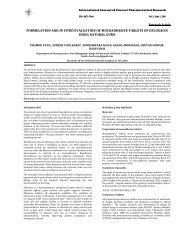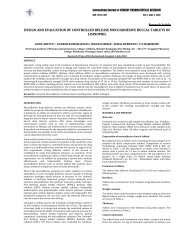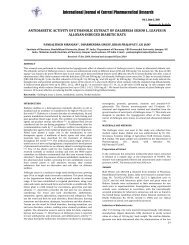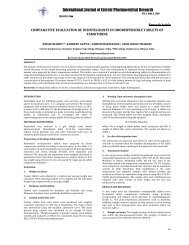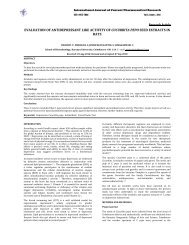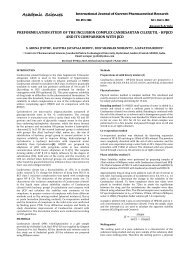International Journal of Current Pharmaceutical Research
International Journal of Current Pharmaceutical Research
International Journal of Current Pharmaceutical Research
Create successful ePaper yourself
Turn your PDF publications into a flip-book with our unique Google optimized e-Paper software.
MATERIALS AND METHODS<br />
Sudarshan churna (SC) and Bhaskar lavan churna (BLC) were<br />
procured from local market. Crospovidone was gift sample from<br />
MAPLE biotech Pvt. Ltd. Pune, India and other substances used in<br />
the study ammonium bicarbonate, spray dried lactose, talc, poly<br />
vinyl pyrrolidone (PVP), and sodium lauryl sulphate (SLS) were<br />
purchased from S.D. Fine Chemicals, Mumbai. Aspartame was<br />
obtained from Cipla Pharma. Ltd. Vikroli, Mumbai. Other reagents<br />
were <strong>of</strong> analytical grade.<br />
Methods<br />
Preparation <strong>of</strong> fast dissolving tablets <strong>of</strong> sudarshan and bhaskar<br />
lavan churnas by vacuum drying technique: The fast dissolving<br />
tablets <strong>of</strong> sudarshan and Bhaskar lavan churnas were prepared by<br />
wet granulation method using aqueous solution <strong>of</strong> 1% w/w PVP as<br />
binder for all formulation. The granules are prepared by passing the<br />
damp mass through sieves # 16. The wet granules were then dried<br />
at 60 0C in hot air oven. Dried granules (22/44) were taken and<br />
mixed with spray dried lactose, aspartame, superdisintegrant and<br />
different concentration <strong>of</strong> ammonium bicarbonate in a plastic<br />
container followed by compression <strong>of</strong> blend on a 10‐station rotary<br />
punch‐tabletting machine (Rimek mini Press‐1) using 12mm<br />
concave punches at hardness <strong>of</strong> 4 to 4.50 kg/cm 2 prior to<br />
compression <strong>of</strong> granules in to tablets, tabletting properties such as<br />
angle <strong>of</strong> repose, % compressibility were determined for all the<br />
formulations. After compression the tablet were collected and<br />
vacuum dried at 60 0 C until a constant weight was obtained to ensure<br />
the compete removal <strong>of</strong> sublimable compound to make the tablet<br />
porous. Schematics figure <strong>of</strong> Vacuum drying method for designing <strong>of</strong><br />
fast dissolving tablets is shown in Fig 1. Different formulations were<br />
prepared by vacuum drying technique compositions <strong>of</strong> which are<br />
given in Table 1.<br />
Table 1: Formulae used in the preparation <strong>of</strong> tablets containing sudarshan churna (sc) and bhaskar lavan churna (blc).<br />
Ingredients (mg/tab) SC1 SC2 SC3 BLC1 BLC2 BLC3<br />
SC/BLC 500 500 500 500 500 500<br />
Crospovidone 32.5 32.5 32.5 32.5 32.5 32.5<br />
Spray dried Lactose 75.25 62.25 36.25 75.25 62.25 36.25<br />
Ammonium bicarbonate 13 26 52 13 26 52<br />
PVP 6.5 6.5 6.5 6.5 6.5 6.5<br />
Talc 6.5 6.5 6.5 6.5 6.5 6.5<br />
Aspartame 13 13 13 13 13 13<br />
SLS. 3.25 3.25 3.25 3.25 3.25 3.25<br />
Total weight 650 650 650 650 650 650<br />
Evaluation <strong>of</strong> tablets<br />
All the formulated tablets were evaluated for weight variation,<br />
hardness, thickness, friability, wetting time, disintegration time and<br />
stability study. In the weight variation test, 20 tablets were selected<br />
at random and the average weight was calculated. Then, individual<br />
tablets were weighed and the weight was compared with an average<br />
weight. Pfizer hardness tester was used for the determination <strong>of</strong><br />
hardness <strong>of</strong> the tablet. The tablet was placed in contact b/w the<br />
plungers and the handle pressed. The force <strong>of</strong> fracture was recorded.<br />
The thickness <strong>of</strong> the tablet was recorded during the process <strong>of</strong><br />
compression using calipers (Mitotoyo Japan). The friability <strong>of</strong> tablets<br />
was determined using a Roche friabilator (Electrolab, EF2<br />
friabilator). Two tablets from each batch takened and placed in the<br />
friabilator then operated for 100 revolutions. Then the tablets were<br />
dedusted and reweighed. Percentage friability was calculated using<br />
the formula,<br />
F = (1‐W0 / W) X 100<br />
In the disintegration time study, the tablets were taken and<br />
introduced in each tube <strong>of</strong> disintegration apparatus and the tablet<br />
rack <strong>of</strong> the disintegration apparatus was positioned in to a 1 liter<br />
beaker containing 900ml <strong>of</strong> distilled water and time <strong>of</strong><br />
disintegration was recorded at 37±20C. internal diameter 6.5cm) containing 5ml <strong>of</strong> distilled water. A tablet<br />
was placed on the paper and time for complete wetting <strong>of</strong> the tablets<br />
was measured in seconds. The stability study <strong>of</strong> the tablets was<br />
carried out according to ICH guidelines, by storing the tablets in<br />
stability chamber (Lab‐Care, Mumbai) at 40±2<br />
In the wetting time study, a<br />
piece <strong>of</strong> tissue paper folded twice was placed in a petridish (with<br />
0C/75 ± 5%RH for<br />
three months. At the end <strong>of</strong> each month tablets were tested for<br />
disintegration time and wetting time.<br />
RESULTS AND DISCUSSION<br />
Flow properties <strong>of</strong> sudarshan and bhaskar lavan powders were<br />
analyzed before compression to tablets. The high values <strong>of</strong> angle <strong>of</strong><br />
repose (SC≥42.22 and BLC≥41.17) and % compressibility (SC≥55.66<br />
and BLC≥52.48) clearly indicates that both churnas were not free<br />
flowing powders. So in order to improve flow properties <strong>of</strong> powders<br />
a lubricant (talc) and glident (SLS) were incorporated into the<br />
churna powders. Even after addition <strong>of</strong> lubricant and glident also,<br />
there was no improvement in flow property <strong>of</strong> churnas. That is why,<br />
the powder blends <strong>of</strong> sudarshan and bhaskar lavan churnas were<br />
converted into the granules by using aqueous solution <strong>of</strong> 1% w/w<br />
PVP. The values <strong>of</strong> pre‐compression parameters <strong>of</strong> both churnas<br />
granules evaluated were within prescribed limits and indicated good<br />
free flowing property (Table 2). Then granules were compressed<br />
into tablets on a 10‐station rotary punching machine (Rimek mini<br />
Press‐1) using 12mm concave punch.<br />
Table 2: Precmpressional parameters <strong>of</strong> granules<br />
Formulation Angle <strong>of</strong> repose<br />
Compressibility<br />
Bulk density Tapped density Hausner’s Ratio<br />
Code<br />
(Ө) (±SD), n=3<br />
(%) (±SD), n=3<br />
(gm/cc) ± SD, n=3 (gm/cc) ± SD, n=3 ± SD, n=3<br />
SC 1 23.65 (0.22) 16.66 (0.72) 0.43 (0.006) 0.55 (0.02) 1.27 (0.03)<br />
SC 2 24.22 (0.52) 17.72 (0.52) 0.44 (0.007) 0.52 (0.02) 1.18 (0.04)<br />
SC 3 23.70 (0.62) 19.54 (0.55) 0.45 (0.004) 0.51 (0.01) 1.13 (0.03)<br />
BLC 1 22.49 (0.92) 18.59 (1.22) 0.44 (0.006) 0.54 (0.02) 1.22 (0.03)<br />
BLC 2 23.52 (0.72) 18.33 (0.92) 0.42 (0.004) 0.53 (0.01) 1.26 (0.03)<br />
BLC 3 21.58 (0.55) 19.22 (0.99) 0.44 (0.002) 0.55 (0.02) 1.25 (0.04)<br />
Note: Values in parenthesis are standard deviation (±SD)<br />
In all formulations, the hardness test indicates good mechanical<br />
strength. Hardness <strong>of</strong> tablets decreased with increase in the amount<br />
<strong>of</strong> volatile component 14 (Fig 2‐3). Friability <strong>of</strong> all the formulations<br />
less than 1%, it indicates that the tablets had good mechanical<br />
resistance. The wetting time and disintegration time values<br />
decreased with increase in the concentration <strong>of</strong> volatile component<br />
(Fig 2‐3). It may be due to their lowest hardness and the maximum<br />
porous structure was responsible for faster water uptake, hence it<br />
facilitates wicking action <strong>of</strong> crospovidone in bringing about faster<br />
disintegration 15 (Table 3). Vacuum drying techniques use to prepare<br />
highly porous compressed tablets (mentioned in Fig 1) that were<br />
rapidly soluble in saliva. Crospovidone containing tablets rapidly<br />
exhibit high capillary activity and pronounced hydration with a little<br />
tendency to gel formation 16 and thus disintegrate tablets rapidly.<br />
37


